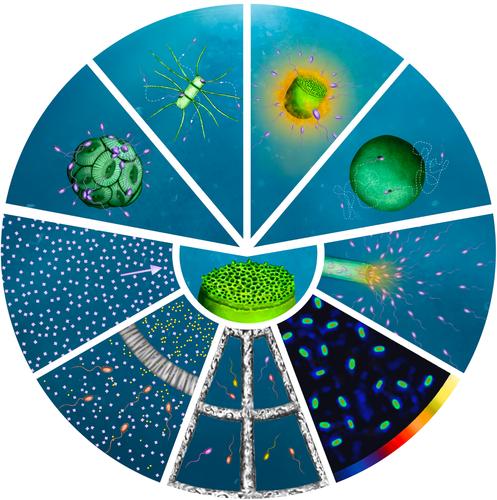当前位置:
X-MOL 学术
›
Mol. Microbiol.
›
论文详情
Our official English website, www.x-mol.net, welcomes your
feedback! (Note: you will need to create a separate account there.)
Space, the final frontier: The spatial component of phytoplankton–bacterial interactions
Molecular Microbiology ( IF 2.6 ) Pub Date : 2024-07-06 , DOI: 10.1111/mmi.15293 Clara Martínez-Pérez 1 , Sophie T Zweifel 1 , Roberto Pioli 1 , Roman Stocker 1
Molecular Microbiology ( IF 2.6 ) Pub Date : 2024-07-06 , DOI: 10.1111/mmi.15293 Clara Martínez-Pérez 1 , Sophie T Zweifel 1 , Roberto Pioli 1 , Roman Stocker 1
Affiliation

|
Microscale interactions between marine phytoplankton and bacteria shape the microenvironment of individual cells, impacting their physiology and ultimately influencing global-scale biogeochemical processes like carbon and nutrient cycling. In dilute environments such as the ocean water column, metabolic exchange between microorganisms likely requires close proximity between partners. However, the biological strategies to achieve this physical proximity remain an understudied aspect of phytoplankton–bacterial associations. Understanding the mechanisms by which these microorganisms establish and sustain spatial relationships and the extent to which spatial proximity is necessary for interactions to occur, is critical to learning how spatial associations influence the ecology of phytoplankton and bacterial communities. Here, we provide an overview of current knowledge on the role of space in shaping interactions among ocean microorganisms, encompassing behavioural and metabolic evidence. We propose that characterising phytoplankton–bacterial interactions from a spatial perspective can contribute to a mechanistic understanding of the establishment and maintenance of these associations and, consequently, an enhanced ability to predict the impact of microscale processes on ecosystem-wide phenomena.
中文翻译:

太空,最后的边界:浮游植物与细菌相互作用的空间成分
海洋浮游植物和细菌之间的微尺度相互作用塑造了单个细胞的微环境,影响其生理机能,并最终影响碳和营养物质循环等全球规模的生物地球化学过程。在海水柱等稀释环境中,微生物之间的代谢交换可能需要伙伴之间非常接近。然而,实现这种物理接近的生物学策略仍然是浮游植物-细菌关联的一个未被充分研究的方面。了解这些微生物建立和维持空间关系的机制,以及空间接近性在多大程度上是相互作用发生的必要条件,对于了解空间关联如何影响浮游植物和细菌群落的生态学至关重要。在这里,我们概述了当前关于空间在塑造海洋微生物之间相互作用中的作用的知识,包括行为和代谢证据。我们建议从空间角度描述浮游植物-细菌相互作用有助于对这些关联的建立和维持的机制理解,从而增强预测微尺度过程对整个生态系统现象的影响的能力。
更新日期:2024-07-06
中文翻译:

太空,最后的边界:浮游植物与细菌相互作用的空间成分
海洋浮游植物和细菌之间的微尺度相互作用塑造了单个细胞的微环境,影响其生理机能,并最终影响碳和营养物质循环等全球规模的生物地球化学过程。在海水柱等稀释环境中,微生物之间的代谢交换可能需要伙伴之间非常接近。然而,实现这种物理接近的生物学策略仍然是浮游植物-细菌关联的一个未被充分研究的方面。了解这些微生物建立和维持空间关系的机制,以及空间接近性在多大程度上是相互作用发生的必要条件,对于了解空间关联如何影响浮游植物和细菌群落的生态学至关重要。在这里,我们概述了当前关于空间在塑造海洋微生物之间相互作用中的作用的知识,包括行为和代谢证据。我们建议从空间角度描述浮游植物-细菌相互作用有助于对这些关联的建立和维持的机制理解,从而增强预测微尺度过程对整个生态系统现象的影响的能力。






























 京公网安备 11010802027423号
京公网安备 11010802027423号